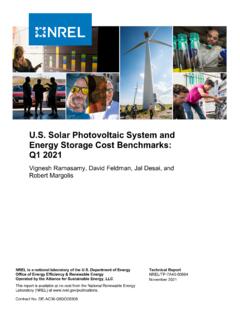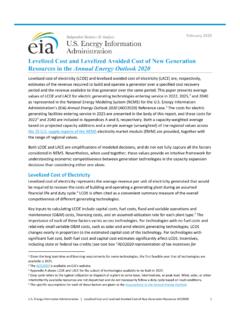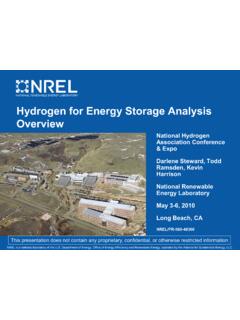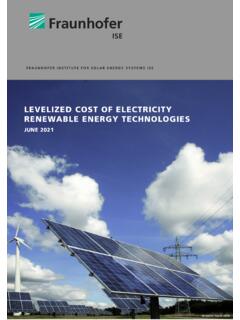Transcription of Compressed Air Energy Storage
1 Compressed Air Energy Storage : Grid-Scale Technology for Renewables Integration in the Pacific Northwest PROJECT HIGHLIGHTS. In the first project of its kind, the Bonneville Power Administration teamed with the Pacific Northwest National Laboratory and a full complement of industrial and utility partners to evaluate the technical and economic feasibility of developing Compressed air Energy Storage (CAES) in the unique geologic setting of inland Washington and Oregon. The project team extended analysis of traditional CAES. Storage in salt caverns to much more prevalent underground porous and permeable rock structures. Doing so resulted in a set of significant advancements to CAES concepts and to its fundamental value proposition beyond traditional peak to off-peak load shifting.
2 Key findings include: Eastern Washington and Oregon are rich with potentially suitable sites for CAES, with access to the required infrastructure and geological Storage reservoir. Screening identified five candidate locations, which were narrowed to two areas for detailed assessment of subsurface Storage capacity, power plant design, transmission interconnection, and economic feasibility. A conventional CAES plant was designed and analyzed for a first site located at Columbia Hills in Washington State. The plant design offers 231 MW of load during Storage and 207 MW of generation. This configuration offers an estimated 40 days of continuous Storage capacity, which could provide over 400 hours of subsequent generation without further injections.
3 Simplified economic analysis indicates the installed capital cost would be similar to conventional combined- cycle gas turbines, and at a levelized cost of electricity (LCOE) as low as cents per kilowatt-hour (kWh), is competitive with most generating options within the region. A new type of no-fuel hybrid geothermal CAES plant was designed for a site located near Yakima Canyon north of Selah (Yakima Minerals). Constraints on natural gas supply were identified after this site was selected, which necessitated development of this new CAES plant configuration. The plant design at this location offers 150 MW of load during Storage and 83 MW of generation capacity.
4 The Storage reservoir at this site is very deep. The high pressure and Storage density, combined with a very large reservoir structure, result in a high capacity reservoir; simulations show that less than 20% of the reservoir volume would be filled after a year of continuous air injection. The estimated LCOE of cents per kWh could be competitive with the region's peaking and renewables generation. Both plant configurations evaluated would be capable of providing balancing (increasing or decreasing reserve), Energy production, and peaking capacity within ten minute response time standards. Utilization of widely available, high-capacity porous rock structures could offer a unique opportunity for CAES to provide grid-scale Energy Storage capacity, seasonal load shifting, load balancing, peaking reserves, and traditional diurnal peak-to-off-peak load shifting.
5 This technology could integrate well into the region's resource portfolio, with the ability to tailor plant design, Storage reservoir siting and development, and project management to the operator's specific needs and business case. PNNL REPORT ON Compressed AIR Energy Storage IN THE PACIFIC NORTHWEST. Compressed Air Energy Storage BPA and other regional electric utilities have experienced very large increases in requirements to When off-peak power is available or hold costly capacity reserves on the system, in order additional load is needed on the grid for balancing, that excess power can be used to to respond quickly to large, unscheduled ramping compress air and store it in deep geologic by the fleet of regional wind generation.
6 This can be reservoirs. When additional generation compounded when high water flows in the spring lead is needed, the stored high-pressure air is to the curtailment of power production from wind returned to the surface and used to produce resources, and environmental requirements mandate the power. To date, there are two operating use of hydroelectric turbines (rather than spilling all the CAES plants in the world; a 110 MW plant excess flow over the dams) to maintain dissolved gases in McIntosh, Alabama, commissioned in the Columbia River at appropriate levels. For these in 1991 and a 290 MW plant in Huntorf, reasons, and because of the significant growth in wind Germany built in 1978.
7 Both plants store generation capacity to date as well as additional growth air underground in excavated salt caverns expected over the coming years, there is strong interest produced by solution mining. The Pacific in novel opportunities for integrating these intermittent Northwest doesn't have this type of geology renewable resources while ensuring the stability and for Storage , but the region is home to reliability of transmission in BPA's service territory. extensive deposits of porous, permeable rocks that could be used for air Storage . BPA has identified Energy Storage as a critical technology with the potential to enhance grid stability, increase operational transfer capability, and prevent and mitigate the impacts of extreme events to the grid.
8 Technology breakthroughs are needed that dramatically reduce the costs of large-scale (gigawatt-hour level) Energy Storage systems to drive revolutionary changes in the design and operation of the electric power system. This study began with a regional survey that identified five candidate areas where geology and infrastructure appeared to offer potential as a CAES site. Of these, two sites were selected for core geologic simulation work, which in turn was used to inform design and modeling of preliminary plant configurations. The characteristics of each site and especially the constraints on natural gas supply at one site resulted in very different design and operational approaches.
9 However, in both cases, a technologically viable first-order1 configuration was Map showing important generation and distribution designed and modeled to take the greatest advantage infrastructure relative to the location of the Columbia of local surface and subsurface conditions, and to best River Basalts (shaded area), which are studied here as potential Storage reservoirs. mitigate the challenges at each site. Site-specific system designs and costs, including levelized costs of electricity (LCOEs) were developed based on the chosen 1. Plant configurations designed for these sites are heavily dependent upon geologic site characterization to CAES PROJECT SITING.
10 Quantitatively determine reservoir conditions, which will affect compression, injection, and production system design. The Pacific Northwest region east of the Cascade 2. As a technical siting and feasibility study, the consumption Mountain Range is dominated by the Columbia Plateau of grid-supplied Energy during compression was maintained as a zero cost attribute. Province (CPP). The CPP predominantly consists of a set 2. of continental flood basalt deposits that cover over 81,000 mi2 of portions of eastern Washington, Preferred Surface Siting Guidelines northeastern Oregon, and western Idaho, with a total Proximity to existing high-voltage lines composite volume of more than 53,700 mi3.








